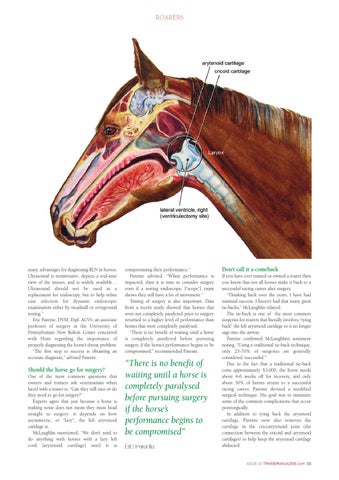ROARERS
many advantages for diagnosing RLN in horses. Ultrasound is noninvasive, depicts a real-time view of the tissues, and is widely available… Ultrasound should not be used as a replacement for endoscopy, but to help refine case selection for dynamic endoscopic examination either by treadmill or overground testing.” Eric Parente, DVM, Dipl. ACVS, an associate professor of surgery at the University of Pennsylvania’s New Bolton Center concurred with Hunt regarding the importance of properly diagnosing the horse’s throat problem. “The first step to success is obtaining an accurate diagnosis,” advised Parente.
Should the horse go for surgery? One of the most common questions that owners and trainers ask veterinarians when faced with a roarer is, “Can they still race or do they need to go for surgery?” Experts agree that just because a horse is making noise does not mean they must head straight to surgery: it depends on how asymmetric, or “lazy”, the left arytenoid cartilage is. McLaughlin mentioned, “We don’t tend to do anything with horses with a lazy left cord [arytenoid cartilage] until it is
compromising their performance.” Parente advised, “When performance is impacted, then it is time to consider surgery even if a resting endoscopic [“scope”] exam shows they still have a lot of movement.” Timing of surgery is also important. Data from a recent study showed that horses that were not completely paralyzed prior to surgery returned to a higher level of performance than horses that were completely paralysed. “There is no benefit of waiting until a horse is completely paralyzed before pursuing surgery if the horse’s performance begins to be compromised,” recommended Parente.
“There is no benefit of waiting until a horse is completely paralysed before pursuing surgery if the horse’s performance begins to be compromised” Eric Parente
Don’t call it a comeback If you have ever trained or owned a roarer then you know that not all horses make it back to a successful racing career after surgery. “Thinking back over the years, I have had minimal success. I haven’t had that many great tie-backs,” McLaughlin relayed. The tie-back is one of the most common surgeries for roarers that literally involves “tying back” the left arytenoid cartilage so it no longer sags into the airway. Parente confirmed McLaughlin’s sentiment noting, “Using a traditional tie-back technique, only 25-70% of surgeries are generally considered ‘successful.’” Due to the fact that a traditional tie-back costs approximately $3,000, the horse needs about 4-6 weeks off for recovery, and only about 50% of horses return to a successful racing career, Parente devised a modified surgical technique. His goal was to minimize some of the common complications that occur postsurgically. In addition to tying back the arytenoid cartilage, Parente now also removes the cartilage in the cricoarytenoid joint (the connection between the cricoid and arytenoid cartilages) to help keep the arytenoid cartilage abducted.
ISSUE 40 TRAINERMAGAZINE.com 53
